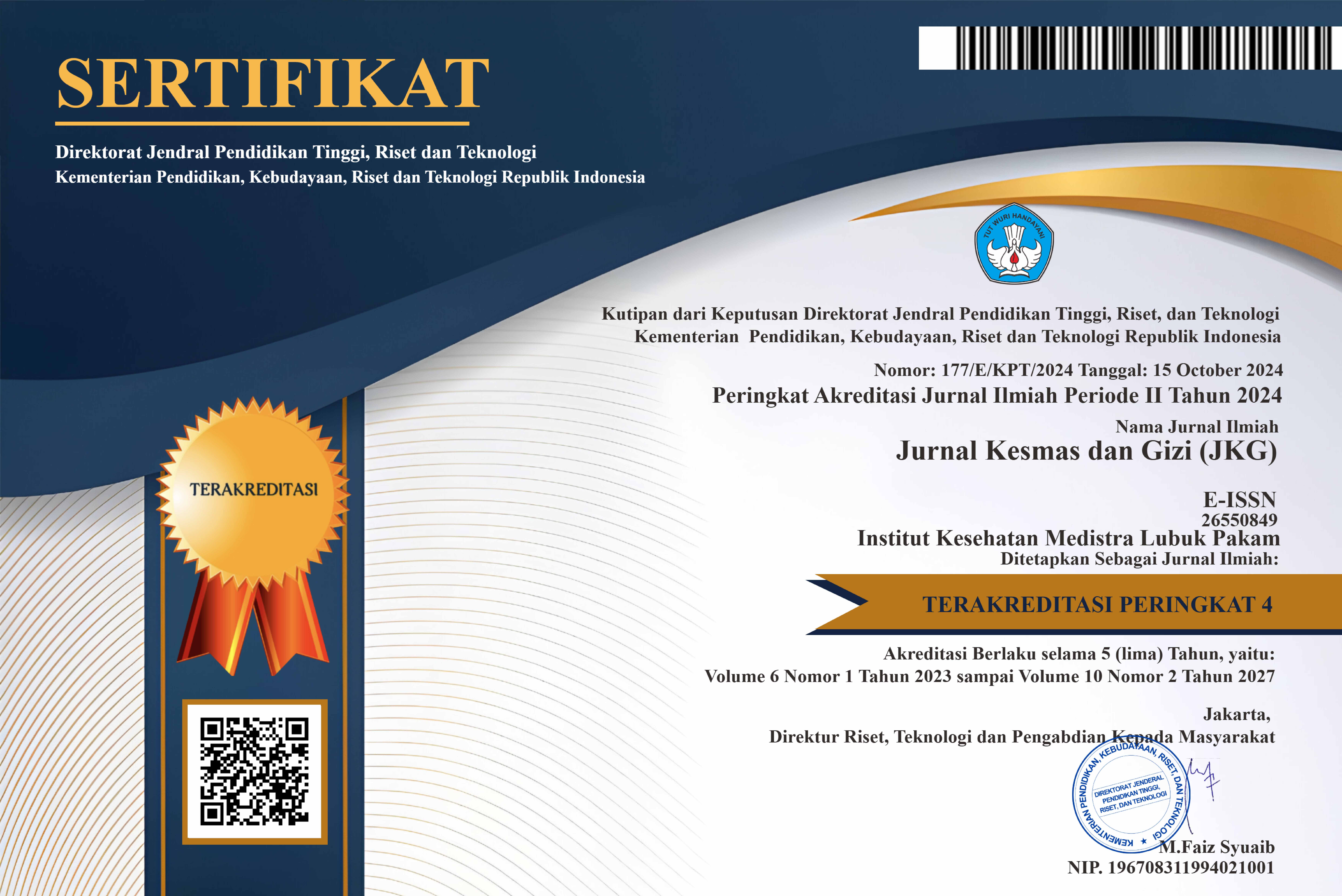THE EFFECT OF DHIKR THERAPY ON REDUCING PAIN INTENSITY IN POST-CARDIAC CATHETERIZATION PATIENTS IN GRANDMED HOSPITALS LUBUK PAKAM
DOI:
https://doi.org/10.35451/jkg.v6i1.1836Keywords:
Dhikr Therapy, Heart failure, PCI, PainAbstract
Data reported by WHO (Word Health Organization) in 2020 shows that the death rate from cardiovascular disease, especially in developing countries, is increasing every year. Cardiac catheterization is an action that has the highest level of accuracy (96% - 99%) for detecting abnormalities in the heart, especially coronary heart disease. Patients who have heart disease often experience chest pain. Spiritual therapy in the form of dhikr is a non-pharmacological therapy that is thought to reduce pain. Quasi-experimental research design using a pre-test and post-test design without any control measures accompanied by an observation sheet which contains a pain level measurement scale (VAS) used in this research. Quota sampling was used in the research by selecting 20 post-cardiac catheterization patients as research respondents. The results of testing the effect of this research used a sample paired T test where the average pre-test difference was 1,250. This showed that there were differences in results before (pre-test) and (post-test). The p-value obtained was .001, which means that there was a significant effect after giving dhikr therapy on reducing pain intensity. It is hoped that this dhikr therapy technique can be used as a nursing intervention so that it can reduce the pain felt by patients.
Downloads
References
Action on smoking and health (2018) `what`sin a Cigarette?`, Action on smoking and health, pp. 1-4. Available at: http://www.ash.org.uk/files/documents/ASH_117.pdf.
AHA. Pengertian Jantung Koroner. Konsep Penyakit Jantung Koroner. 2012.
Asmadi, A. (2018). Teknik Prosedural Keperawatan: konsep dan aplikasi kebutuhan dasar klien (19).Salemba Medika.
Al Khayyal, H., El Geneidy, M., & El Shazly, S. A. M (2016). Elder`s Knowledge about Risk Factors of Coronary Heart Disease, Their Perceived Risk, and Adopted Preventive Behaviors. Journal of Education and Practice, 7(10), 89-98.
Al Khayyal, H., El Geneidy, M.,& El Shazly, S. A. M. (2016). Elders’ Knowledge about Risk Factors of Coronary Heart Disease, Their Perceived Risk, and Adopted Preventive Behaviors. Journal of Education and Practice, 7(10), 89-98.
Andlyany. 2010. Al-qur’an Terjemahan Inonesia.
Binokar, S. V., and Guruprasad. (2017). Coronary Artery Disease. Bilaspur: E ducreation Publishinng.
Brunner & Suddarth (2013). Buku Ajar Keperawatan Medikal Bedah Edisi 8 Volume 2. Jakarta EGC
Dandaker, Vineet., I. V., Adhir R. S. (2012). Complications of Transradial Catheterization. Cardiovascular Revascularization Medicine, 39-50
Editore, S. (2014). Diagnostic Coronary Angiography, Milan: EBMGuyton, A. C., Hall, J, E., (2014). Buku Ajar Fisiologi Kedokteran. Edisi 12. Jakarta : EGC
Fitroti, Z., A. K. U. (2018). Faktor-Faktor Prediksi Spiritualitas Pada Pasien Kemoterapi Wanita Dengan Kanker Paud Prof Dr Margono Soekarjo Purwokerto. Universitas Muhammadiyah Purwokerto.
Herselia, S. A. (2018). Tindakan Percutaneous Coronary Intervention Pada Pasien Stenosis Arteri Koroner Kanan. Jurnal Arsip Kardiovaskular Indonesia (ARKAVI), 3(1), 186-191.
Ho, H. H., Fahim H. J., Paul J. O. (2012). Radial Artery Spasm during Transradial Cardiac Catheterization and percutaneous Coronary Intervention: Incidence, Predisposing Factors, Prevention, and Management. Cardiovascular Revascularization Medicine, 193-195Himawan, Riska, dkk. 2019. Pengaruh terapi dzikir terhadap tingkat nyeri pada pasien post operasi benigna prostat hyperplasia di RSUD RA. KARTINI Jepara. Jurnal Keperawatan dan Kebidanan Vol. 10. No 1
Husna, N. (2020) ‘Faktor-Faktor Yang Mempengaruhi Laju Kekambuhan Penderita Penyakit Jantung Koroner di RSUD kota Langsa Tahun 2017
Ikhsan, M. (2016). The Role of Duke Treadmill Score as a Predictor of Coronary Artery Disease in Patient With Positive Treadmill Test Result. Jurnal Penyakit Dalam Indonesia Vol.3 No.2, 81-87
Kemenkes RI.(2019). Buku Pintar Kader, Posbindu, Buku Pintar Kader Posbindu, 1-65.
Kemenkes, R. (2018). Hasil Utama Riskesdas 2018. In Online) Http://Www. Depkes.
Kern MJ. The Basics of Percutaneous Coronary Interventions. In: The Interventional Cardiac Catheterization Handbook. 2017.
Khaled,A. 2007. The Power of Dzikir, Jakarta: Amzah.
Knuuti, J., Wijns, W.,saraste, A., & Capodanno, D. (2020). 2019 ESC Guidelinesfor the diagnosis and management of chronic coronary syndromes. European Heart Journal, 41(3), 407-477.
Kolonzo, B. and Rhona O. (2011). Secondary Preventionand Learning Needs Post Percutaneous Coronary Intervention: Perspectives of Both Patiens and Nurses. Journal of clinical Nursing 20, 1160-1167.
Lanzer, P. (2013). Catheter-Based Cardiovascular Intervention. London: Springer
Mathroni, 2009, Amalan dan do`a Mustajab, Semarang : Aneka Ilmu.
Nurhayati. (2015). Relaksasi Autogenik terhadap penurunan Skala Nyeri pada ibu post operasi Saecarea. Jurnal Skolastik Keperawatan, I.
Downloads
Published
Issue
Section
License
Copyright (c) 2023 Kardina Hayati

This work is licensed under a Creative Commons Attribution 4.0 International License.
Copyright in each article is the property of the Author.


























